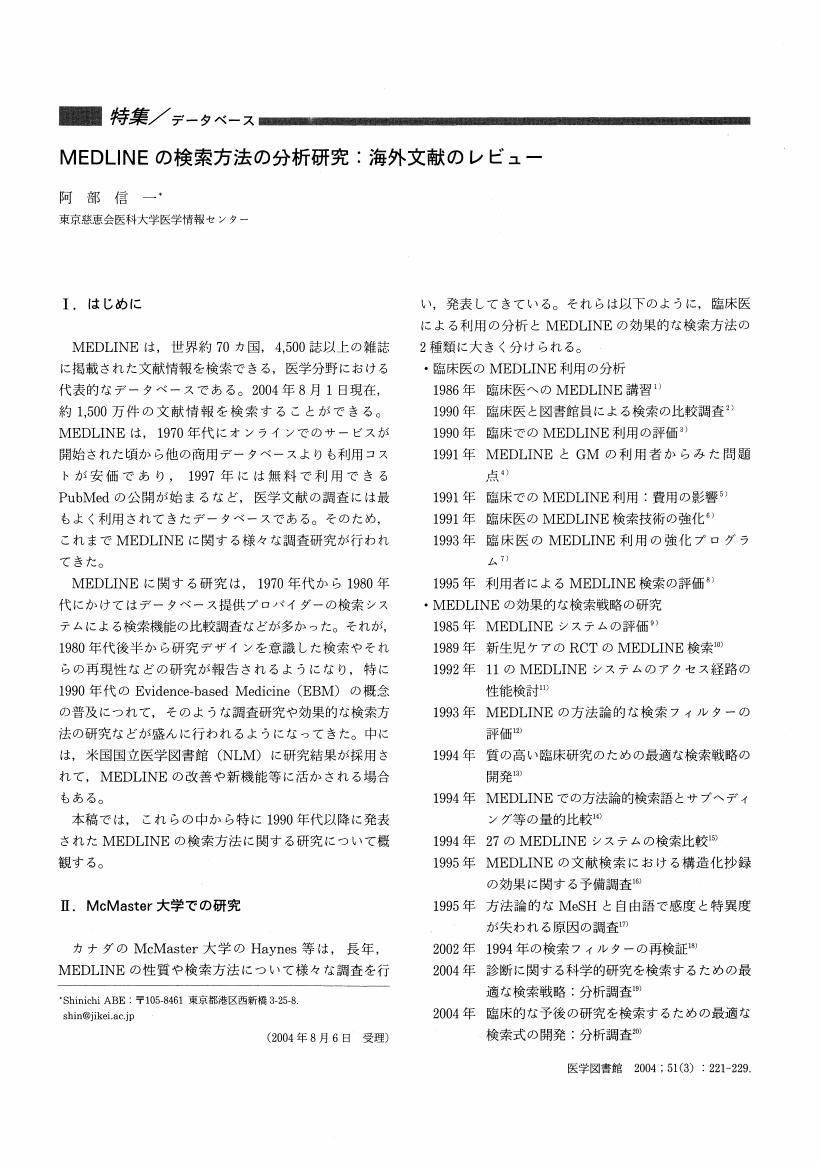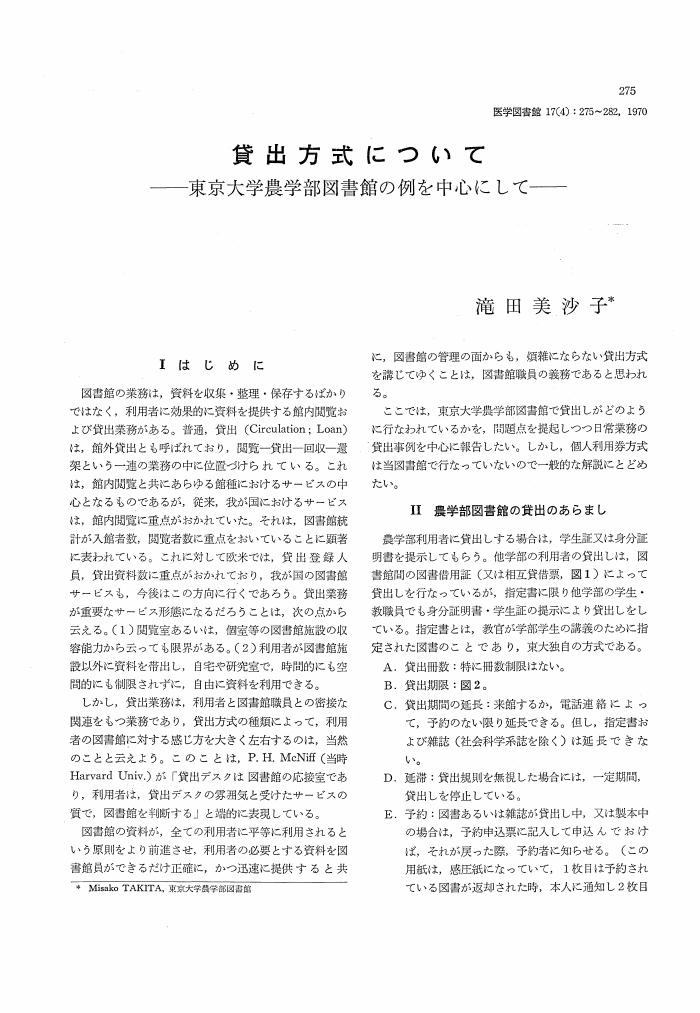- 著者
- 安東 正玄
- 出版者
- 日本医学図書館協会
- 雑誌
- 医学図書館 (ISSN:04452429)
- 巻号頁・発行日
- vol.59, no.1, pp.18-21, 2012-03
2 0 0 0 KOSMOS as a "Discovery Service"? : 慶應義塾大学KOSMOSの現在と,その少し先へ (特集 オンラインリソースのゆくえ : 図書館サービスとの連携を考える)
- 著者
- 保坂 睦
- 出版者
- 日本医学図書館協会
- 雑誌
- 医学図書館 (ISSN:04452429)
- 巻号頁・発行日
- vol.59, no.1, pp.22-27, 2012-03
2 0 0 0 特集 24時間開館
- 出版者
- 日本医学図書館協会
- 雑誌
- 医学図書館 (ISSN:04452429)
- 巻号頁・発行日
- vol.55, no.2, pp.130-160, 2008-06
- 著者
- 北川 昌子
- 出版者
- The Japan Medical Library Association
- 雑誌
- 医学図書館 (ISSN:04452429)
- 巻号頁・発行日
- vol.54, no.3, pp.223-228, 2007
- 著者
- 大野 圭子 村瀬 由紀子
- 出版者
- 日本医学図書館協会
- 雑誌
- 医学図書館 (ISSN:04452429)
- 巻号頁・発行日
- vol.57, no.2, pp.151-155, 2010-06
1 0 0 0 OA 診療ガイドライン文献の分析 MEDLINE を用いたビブリオメトリックス
- 著者
- 青木 仕
- 出版者
- 特定非営利活動法人 日本医学図書館協会
- 雑誌
- 医学図書館 (ISSN:04452429)
- 巻号頁・発行日
- vol.49, no.1, pp.50-58, 2002-03-20 (Released:2011-09-21)
- 参考文献数
- 18
Background: Evidence-based medicine (EBM) is currently dominating the medical field as a keyword that reflects modern medicine, even in Japan. There are four steps to the practice of evidence-based medicine: 1. formulating a clinical question, 2. collecting evidence, 3. appraising the evidence, 4. applying it to the patient. Practice guidelines are the final products in this stepwise process of EBM.Purpose: Practice guidelines are useful for achieving standardization and efficiency in the quality of medicine, and they are important for implementation of EBM. In this paper, the author (s) retrieved practice guideline articles, quantitatively assessed the number of articles, and analyzed their content.Methods: The MEDLINE database was searched for articles indexed under “Practice Guideline” according to “Publication Type”, and the articles retrieved were counted and analyzed with Excel software.Results: A total of 4, 887 practice guidelines were retrieved, 108 of which were published in 1991, versus 436 in 1992, indicating a 4 fold increase in just this one year. The most frequent major descriptors used to index the practice guidelines were “HIV infections” (124 articles), “breast neoplasms” (99), “mass screening” (95), “asthma” (92), and “hypertension” (86).Conclusion: The word “EBM” was first used by GH Guyatt in 1991, and the Cochrane collaboration was started in 1992. The number of practice guidelines has steadily increased since the introduction of EBM. The development of practice guidelines for diseases was found to have surged even in Japan, with many practice guidelines being available for diseases.
1 0 0 0 OA 文献の所在を知るためのトゥール
- 著者
- 太田 泰弘
- 出版者
- 特定非営利活動法人 日本医学図書館協会
- 雑誌
- 医学図書館 (ISSN:04452429)
- 巻号頁・発行日
- vol.39, no.2, pp.196-201, 1992-06-20 (Released:2011-09-21)
- 参考文献数
- 6
1 0 0 0 OA 情報検索によって新しい仮説は発見できるか Don R. Swanson の新理論紹介
- 著者
- 菊池 しづ子
- 出版者
- 特定非営利活動法人 日本医学図書館協会
- 雑誌
- 医学図書館 (ISSN:04452429)
- 巻号頁・発行日
- vol.37, no.1, pp.29-33, 1990-03-20 (Released:2011-09-21)
- 参考文献数
- 11
1 0 0 0 OA MEDLINE の検索方法の分析研究 海外文献のレビュー
- 著者
- 阿部 信一
- 出版者
- 特定非営利活動法人 日本医学図書館協会
- 雑誌
- 医学図書館 (ISSN:04452429)
- 巻号頁・発行日
- vol.51, no.3, pp.221-229, 2004-09-20 (Released:2011-09-21)
- 参考文献数
- 48
1 0 0 0 OA 日本医事新報社を訪ねて
- 著者
- 山崎 茂明
- 出版者
- 特定非営利活動法人 日本医学図書館協会
- 雑誌
- 医学図書館 (ISSN:04452429)
- 巻号頁・発行日
- vol.45, no.2, pp.262-263, 1998-06-20 (Released:2011-09-21)
- 参考文献数
- 7
1 0 0 0 エドワード・ジェンナー『牛痘の原因および作用に関する研究』
- 著者
- 酒井 シヅ
- 出版者
- 特定非営利活動法人 日本医学図書館協会
- 雑誌
- 医学図書館 (ISSN:04452429)
- 巻号頁・発行日
- vol.33, no.2, pp.97-98, 1986
- 著者
- 廣瀬 洋
- 出版者
- 日本医学図書館協会
- 雑誌
- 医学図書館 (ISSN:04452429)
- 巻号頁・発行日
- vol.62, no.2, pp.116-123, 2015-06
1 0 0 0 和歌山県立自然博物館展示「マダニにご注意!!」見学報告
- 著者
- 菅 修一
- 出版者
- 日本医学図書館協会
- 雑誌
- 医学図書館 = Journal of the Japan Medical Libraries Association (ISSN:04452429)
- 巻号頁・発行日
- vol.68, no.4, pp.284-286, 2021-12
- 著者
- 菅 修一
- 出版者
- 日本医学図書館協会
- 雑誌
- 医学図書館 = Journal of the Japan Medical Libraries Association (ISSN:04452429)
- 巻号頁・発行日
- vol.68, no.3, pp.212-215, 2021-10
1 0 0 0 京都府立図書館小展示「京の医学」見学報告
- 著者
- 菅 修一
- 出版者
- 日本医学図書館協会
- 雑誌
- 医学図書館 = Journal of the Japan Medical Libraries Association (ISSN:04452429)
- 巻号頁・発行日
- vol.68, no.3, pp.209-211, 2021-10
- 著者
- 寺升 夕希 藤村 三枝 菅 修一
- 出版者
- 日本医学図書館協会
- 雑誌
- 医学図書館 = Journal of the Japan Medical Libraries Association (ISSN:04452429)
- 巻号頁・発行日
- vol.68, no.3, pp.206-208, 2021-10
- 著者
- 菅 修一
- 出版者
- 日本医学図書館協会
- 雑誌
- 医学図書館 = Journal of the Japan Medical Libraries Association (ISSN:04452429)
- 巻号頁・発行日
- vol.68, no.2, pp.130-132, 2021-06
1 0 0 0 OA 貸出方式について 東京大学農学部図書館の例を中心にして
- 著者
- 滝田 美沙子
- 出版者
- 特定非営利活動法人 日本医学図書館協会
- 雑誌
- 医学図書館 (ISSN:04452429)
- 巻号頁・発行日
- vol.17, no.4, pp.275-282, 1970-12-01 (Released:2011-09-21)
- 参考文献数
- 3
1 0 0 0 アドニス計画の現状と将来
- 著者
- 平野 皓正
- 出版者
- 特定非営利活動法人 日本医学図書館協会
- 雑誌
- 医学図書館 (ISSN:04452429)
- 巻号頁・発行日
- vol.31, no.1, pp.53-54, 1984
1 0 0 0 OA 坪内逍遙編纂小学校国語教科書『國語讀本』の医学教材
- 著者
- 櫻井 待子 菅 修一
- 出版者
- 特定非営利活動法人 日本医学図書館協会
- 雑誌
- 医学図書館 (ISSN:04452429)
- 巻号頁・発行日
- vol.45, no.4, pp.456-462, 1998-12-20 (Released:2011-09-21)
- 参考文献数
- 11





